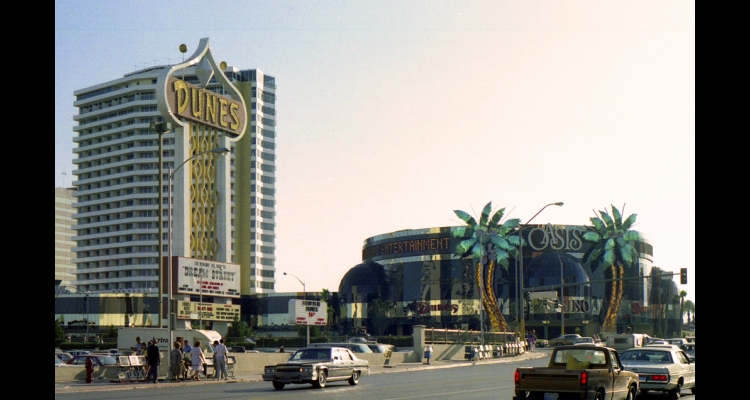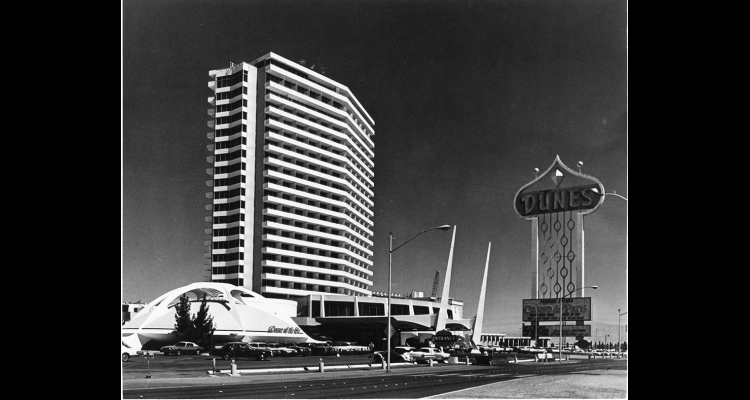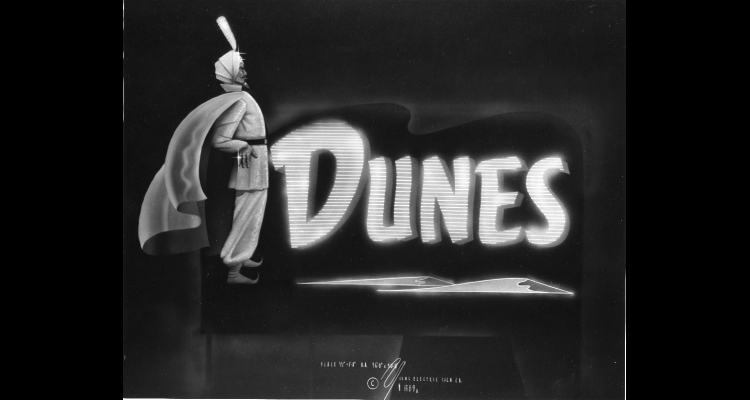Dunes Hotel
One of the venerated original properties associated with the Las Vegas Strip, the Dunes Hotel opened during a mid-1950s casino building boom, and soon became one of its casualties. Over the next four decades, the controversial Dunes would survive a succession of owners, allegations of hidden mob ownership, and marginal profits before it was destroyed to make way for several Las Vegas resorts including the $2 billion Bellagio Hotel.
Originally designed with an Arabian Desert theme, the Dunes was the creation of partners Alfred Gottesman, a former movie theater chain owner; Joe Sullivan, a restaurant owner from Providence, Rhode Island, and Bob Rice, a costume jewelry maker from Beverly Hills. Sullivan was later reputed to be a "front man" whose cash investment actually came from Ray Patriarca, the head of a Rhode Island crime family who expected to reap under-the-table profits from his hidden interest in the casino.
Built at a cost of $3.5 million on the southwestern corner of Flamingo Road and Las Vegas Boulevard, the Dunes debuted on May 23, 1955, just three weeks after the Riviera Hotel had opened several blocks north and only three days before the off-Strip Moulin Rouge Hotel.
At the time, the Dunes, nicknamed "The Miracle in the Desert," was the tenth resort on the Strip and located the farthest south, making it the first hotel-casino seen by those arriving by car from Southern California. The Dunes partners had succeeded in hiring away executives and managers from properties in Miami, Los Angeles, and the nearby Flamingo Hotel. Before opening day, they announced their ambitious expansion plans for 500 more guest rooms, a shopping center, and winter houses on the grounds.
Despite a celebrity-filled debut and plenty of publicity, the Dunes failed within a year, a victim of the overbuilding of resorts on the Strip. The casino itself was forced to close, and the place became what amounted to a motel. It was sold in 1956 to James "Jake"Gottlieb, whose Chicago freight company had received a business loan from the Teamsters Union pension fund controlled by corrupt labor boss James "Jimmy" Hoffa.
Gottlieb, who allegedly had ties to organized crime figures in Chicago, sold a small interest in the hotel to a fellow Chicagoan, Major A. Riddle. The Teamsters pension fund, which Hoffa used to help bankroll other Las Vegas casinos, loaned Gottlieb and Riddle $4 million in 1958. By 1965, the Dunes had an 18-hole golf course and 800 new guest rooms, including a 24-story hotel tower.
In the 1980s, the aging Dunes struggled to stay open. Its new operator was Morris Shenker, the elderly, one-time lawyer for Jimmy Hoffa. The Teamsters Central States Pension Fund loaned Shenker the money he needed to gain control of the Dunes. Federal investigators believed Shenker had a longstanding direct relationship to the Chicago mob.
The Dunes, now nearly thirty years old and in need of renovation, was in decline and in debt. Shenker's group was forced to file for federal bankruptcy protection from creditors, and the resort was sold to wealthy Japanese businessman, Masao Nangaku, who was unsuccessful in his attempts to revive the aging property. Las Vegas casino owner Steve Wynn purchased the Dunes in 1992. Wynn had the old hotel imploded on national television—one tower in 1993 and the other in 1994. Today, the Monte Carlo Hotel, the New York-New York Hotel, and the Bellagio occupy the one-time Dunes hotel site.
Article Locations
Related Articles
None at this time.
Further Reading
None at this time.






